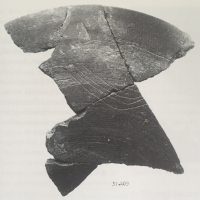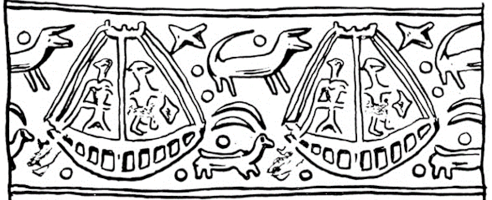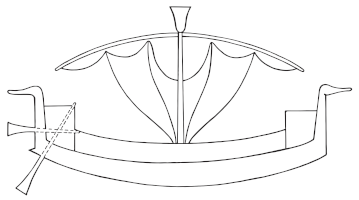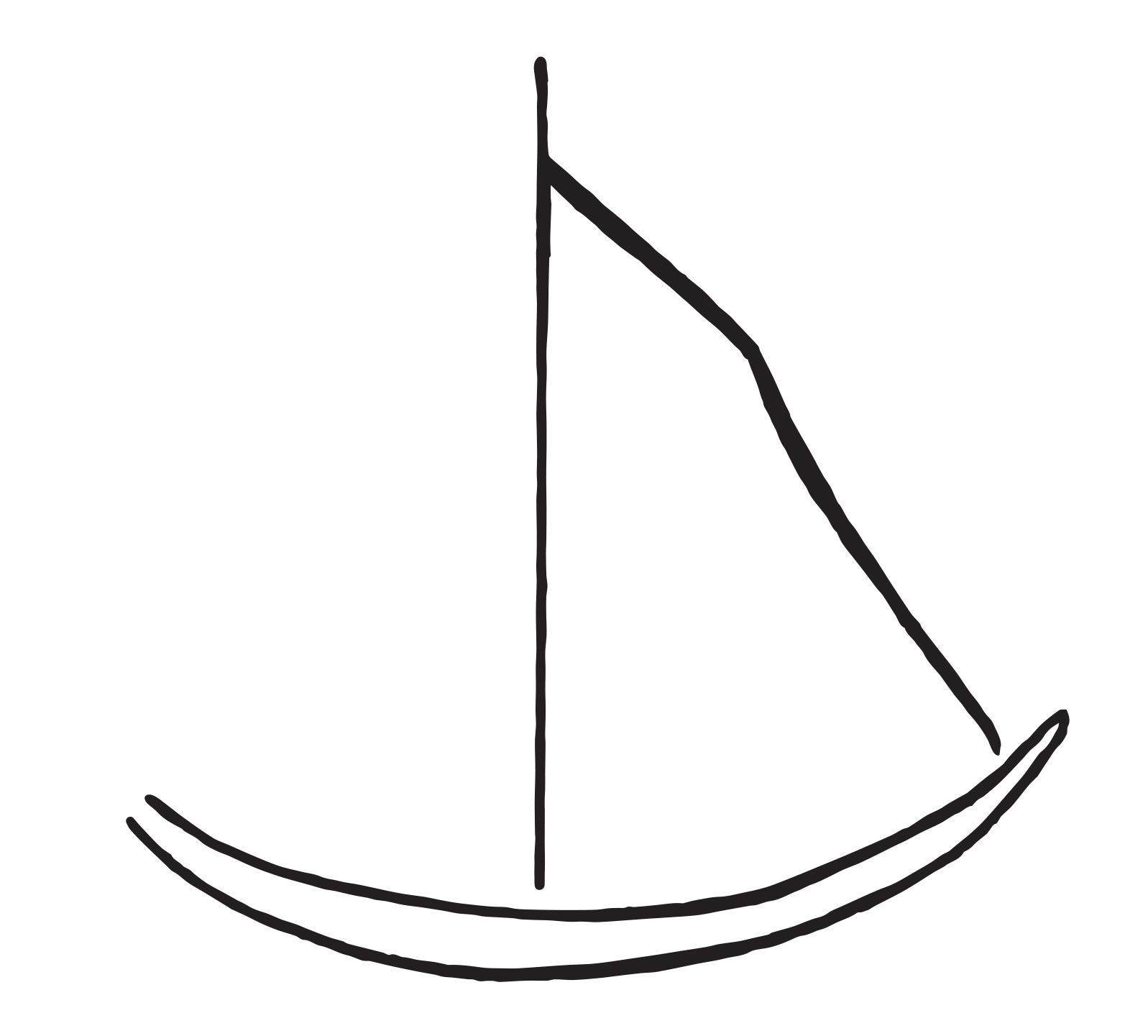A very simple and schematic representation of a sailing ship. Crescentic hull formed by two parallel lines which do not meet at one of the extremities. The mast is represented by a single stroke. One of the stays is fully preserved while the other is mostly effaced. The shape and rendition of the hull is reminiscent of the cylinder seal from Tell Miqne Ekron and the graffito from Tell Abu Hawam which is also dated to the 14th century. Possibly a br type vessel.
ship ingot mark
L16
last quarter of 14th century B.C
Uluburun shipwreck
Ship: L: 17.5 cm; H: 16 cm; Ingot: L: 77.1 cm; H: 43.7 cm; thickness: 4.2 cm
Large oxhide copper ingot (20.4 kg) incised with image of a ship near one of the ingot's ends, roughly midway between the two 'ears'
KW 1526
Pulak 1998: 194-96, fig. 10; 2008: 308, no. 185a; Jones 2007: 96-109 (ingot marks)
None of the Uluburun ingots have primary marks (ie impressed while the metal was still soft). Secondary incised marks were made with a chisel sometimes after the casting of the ingots. Over 187 oxhide ingots and oxhide ingot fragments of the Uluburun shipwreck were incised with secondary marks, comprised of at least 52 different types. Around 30 of the tin ingots and fragments had incised marks with 9 types of symbols - 5 of which are also found on either the oxhide or bun ingots. In all, slightly over half (53%) of the whole copper oxhide ingots and bun ingots (52%) have incised marks. The exact function of these marks is unknown, and could range from denoting ownership, to the receipt of ingots as payment, tax or tribute in a central collecting area. Some ingots have two or as many as three marks, possibly indicating that they passed through the hands of several individuals or locations before becoming part of the ship's cargo. These are almost always placed on different areas of the ingots and never adjacent to each other, thus discounting the possibility of an inscription. Pulak has argued that the exclusive use of secondary incised marks rather than primary ones suggests that they were made at some point of receipt and collection rather than at the production site. This hypothesis is supported by the occasional presence of the same signs on both copper and tin ingots: "As tin and copper would have been mined in different geographical regions, it is highly unlikely that the same mark would have been incised on ingots of dissimilar metals and diverse origins unless this was done at a center that handled both ingot types during the distribution process."(Pulak 1998: 196). The likeliest point of departure of the ship was Tell Abu Hawam (see appendix for argument). Lastly, Pulak observes that many of the incised marks on the Uluburun ingots have distinctly maritime themes, including several forms of fishhooks (1c, 2c, 5c), tridents (2b), a fish (1e), possible quarter rudders (4d, 6b), and a ship (2e). Once again, the choice of symbols lends support to the theory that the signs were made at the point of a central collecting area for transhipment, more specifically a maritime oriented community - ie harbour town. It is interesting to note that a copper oxhide ingot incised with the 'rudder' sign attested from the Uluburun ingots was recently discovered in a metal hoard buried in a LM IB (c. 1500 BC) floor of a structure at Mochlos on Crete (Whitley 2005: 102-103). The find indicates that this type of mark was in use for at least two centuries before the Uluburn ingots.
Likeliest port of origin: Whereas cargo itself is not a reliable pointer of a vessel's origin, there are a number of other categories of objects which are much stronger indicators, all of which are available for the Uluburun ship. These include, in no particular order of importance, galley wares, anchors, cult-related equipment, instruments of trade (weights and their mass standards, forms of currency, writing boards), and personal possessions.
Galley wares: the distinction between galley wares and cargo is not always a straightforward one. With this problem in mind, only the sixteen Canaanite saucer-shaped oil lamps have been considered. Unlike the Cypriot fineware lamps which were carried stacked and in mint condition, these lamps are coarse and were unquestionably used aboard the ship, as evidenced by the soot stains on their rims. Petrographic analysis shows they were all made of the same fabric typical of the Carmel coast, which they share in common with some 82% of the Canaanite jars (Goren 2013: 57). These results are consistent with the distribution of similar lamps, which have turned up at sites such as Tel Michal, Tell Abu Hawam, Megiddo, Tel Dan, Hazor, and Lachish, to name a few (Pulak 2008: 321).
Anchors: petrographic analysis of the 24 anchors recovered from the wreck demonstrates that 22 of them are made of beach rock that incorporates typical Levantine coastal sand, with a ratio of quartz and limestone that resembles that of the temper used for the vast majority of the Canaanite jars as well as the galley wares. In addition, in some of the exemplars the sand also includes grains of volcanic tuff fragments from Cretaceous exposures that can be found on the higher slopes of Mount Carmel, from where they get carried down to the coast by the main rivers which drain the ridge. The petrographic analysis of the anchors has concluded that "the majority are made of beachrock from the Carmel coast, a few of Lebanese beachrock, and one or possibly two of beachrock containing radiolarian chert and ophiolitic minerals from the Ugarit area."(Goren 2013: 58-59). These results accord very well with the geographical distribution of such anchors on typological grounds. Plentiful parallels have been found at dozens of wreck sites off the coast of Israel (Wachsmann 1998: 265-70, 272-73, 285-86; Galili et al 1994), at Ugarit (temple and tomb contexts) and its satellite port of Minet el-Beida (Schaeffer 1978; Frost 1969a; 1991), Byblos (Frost 1969b; Wachsmann 1998: 271-73), the Syro-Palestinian coast more generally, and Kition on Cyprus (Karageorghis 1976a: 875-78; 1976b: 60, 69, 72, 78, 169; Frost 1985; Wachsmann 1998:273-74). Such anchors were apparently manufactured at Tell Abu Hawam and Tell Nami (Bass 1991: 74), and have also been documented from the Cape Gelidonya wreck, but are notably of a type and dimensions that are virtually absent in the Aegean. In addition to provenance, the pattern revealed by the petrographic analysis can shed important light on the ship's itinerary. In fact, these results make a lot of sense if we consider that the anchors would presumably be obtained locally at the port of departure, with anchors lost as the journey progressed continuously replaced either by acquiring new ones at ports along the way, or crafted by the crew from available beachrock (Goren 2013: 55). This would suggest that the vessel was initially supplied with its anchors at a port along the Carmel coast, and replenished lost pieces as it travelled northward up the Lebanese and Syrian coast in the area of Ugarit.
Cult-related equipment: This category comprises objects which are linked to rituals performed aboard the ship, including a cult statue, five faience vessels (four ram-headed and one female-headed), a gold chalice, and possibly an ivory horn and a pair of bronze cymbals. Also relevant to cult is a group of Levantine pendants with symbolic associations. The bronze figurine of a nude female with gold gilding (KW 3680) was arguably the single most important object aboard the ship as it is almost certainly a cult statue of an as yet unidentified goddess. While the Uluburun statuette is unique, the craftsmanship, style and theme are Canaanite, with comparable female deities found throughout the Levant. A gold-sheeted bronze figurine of an enthroned male deity with a very similar hand gesture but in reverse form has been found in a temple context at Tell Abu Hawam.
Closely related to the cult activities which would have surrounded the Uluburun deity is a group of faience vessels, including four ram-headed and one female-headed faience cups which share enough stylistic similarities to suggest that they were producted in the same workshop. Such cups - made in a variety of materials (metal, faience, ceramic) - are considered an important part in Syro-Canaanite art and cult practice, an interpretation that is supported by a clay cup from Ugarit bearing a dedicatory inscription to the Canaanite god Reshef (Zevulun 1987: 100). The explicit association of ram-headed with female-headed cups is furthermore documented at many 14th and 13th century sites where they are found together, suggesting that the two types were used concurrently during ritual activities (Ibid: 92-93, 100, 102). The closest parallel for the Uluburun specimens in terms of both style and shape comes from Tell Abu Hawam, where the same association was found in a temple context, in addition to the gilded bronze figurine of an enthroned male deity with a similar hand gesture to the Uluburun cult statue.
The handleless, pedestal-footed gold chalice (KW 99) is another unique object which accounts for nearly half of the gold carried aboard the ship (236.8g). Although without exact parallels, its Levantine manufacture is suggested by its weight (close to half a mina or 25 units of the 9.4 g Syrian shekel), as well as its hybrid features that draw from a typical form of a Levantine banded stone goblet and Egyptian lotus-shaped chalices encountered in the Levant. This object stands clearly apart from the rest of the gold objects which served as scrap bullion, and most likely functioned either as an incense burner or an offering cup used to perform ceremonies conducted aboard the ship to ensure or give thanks for a safe voyage, as depicted in the famous scene from the tomb of Kenamun.
In sum, the Uluburun wreck indeed shares a large number of parallels in its assemblage with Tell Abu Hawam, including its anchors, the lamps that served as the ship's galley wares, various bead types (small and large glass beads, globular and grain of wheat faience beads), the gold pendant KW 757, the ivory cosmetic spoon, and most of the cult equipment (statue, ivory horn, faience vessels). Most significantly, the site not only provides some of the closest parallels for these individual objects, but for very similar groupings between them, such as the mirrored association of a similar cult statue with ram-headed and female-headed faience cups. Tell Abu Hawam is thus the best candidate for the ship's origin, based on both practical items such as the anchors and galley wares, and the cult-related equipment used by the ship's crew. The importance and size of the site also makes it a realistic candidate as a harbour centre capable of organizing a venture of the scale of the Uluburun.
Jones, M. R. 2007. “Oxhide Ingots, Copper Production, and the Mediterranean Trade in Copper and other Metals in the Bronze Age.” MA dissertation, Texas A&M University, US.
Pulak C. 1998. “The Uluburun shipwreck: An overview,” IJNA 27.3: 188–224.
―――. 2008. “The Uluburun Shipwreck and Late Bronze Age Trade,” in J. Aruz, K. Benzel, and J.M. Evans (eds.) Beyond Babylon: Art, Trade, and Diplomacy in the Second Millennium B.C. New York: Metropolitan Museum of Art, pp. 288-305.










